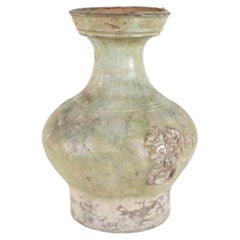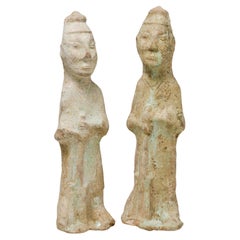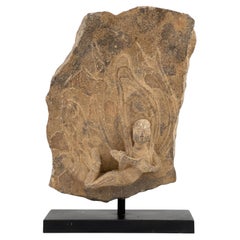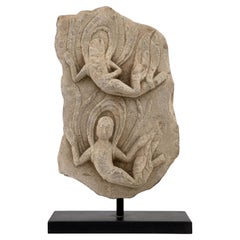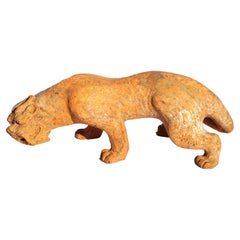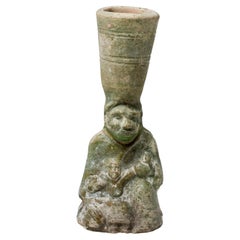Han Furniture
to
22
71
26
125
13
198,573
113,671
43,657
33,668
16,138
12,260
10,805
10,769
9,926
8,928
7,247
6,803
6,428
6,399
6,156
5,895
4,939
3,806
95
9
21
13
4
6
3
1
105
51
24
20
19
133
131
89
36
4
138
138
138
Style: Han
A Han (206BC -220AD) Glazed Hu Vessel
Located in Chicago, IL
This is a fine, heavily patinated example of a Han hu wine storage vessel, buried for the afterlife. The compressed globular body narrows to a slender waisted neck, covered with a da...
Category
15th Century and Earlier Chinese Antique Han Furniture
Materials
Terracotta
Two Green glazed Figures Holding Pitchpork
Located in seoul, KR
Han dynasty pottery tomb figure, modelled standing holding a Pitchpork in front of his body, covered in a turquoise-green glaze. These two pieces are believed to have been produced i...
Category
15th Century and Earlier Hong Kong Antique Han Furniture
Materials
Pottery
$2,970 / set
Apsara Carved Limestone Stele with Extremely Rare 'Oolitic silica', Wei Dynasty
Located in seoul, KR
The small dots apparent on the surface of this stone stele are indicative of an oolitic silica structure or oolites formed in what is known as "Oolitic chert." The same phenomenon can also be observed in the Tang Dynasty Limestone Stele at the Asian Art Museum in San Francisco. This formation occurs gradually over the course of thousands to several hundred thousand years within the soil or sea. Similar structures are commonly found in ancient fossils or arrowheads. Ancient peoples chose certain types of stones for tool-making, preferring materials that were easier to work with and could be sharpened effectively. This predilection is believed to be the reason why oolitic silica structures are frequently found in ancient arrowheads.
The development of these oolitic silica structures is a very slow process involving the accumulation of siliceous layers around particulates. This phenomenon, where silica reacts with water to form layers around a nucleus, occurs under specific chemical and physical conditions. Typically, it takes thousands to hundreds of thousands of years for silica to gradually accumulate in layers through contact with moisture, a process that requires a precise harmony of many variables, including chemical conditions, temperature, pressure, pH, and biological activity.
It is known that no other stele with such a silica structure has been identified to date, serving not only as evidence of its authenticity but also significantly enhancing the rarity of this piece.
This stele appears to be a stone sculpture of an apsara, a celestial nymph from Buddhist and Hindu traditions. Despite its fragmentary state, the sculpture conveys grace and movement. The apsara is captured in a dynamic pose, perhaps once part of a larger tableau, playing a flute-like instrument.
The black stand was made in Hong Kong at the time of the acquisition.
Date : Northern Wei/Eastern Wei Dynasty(386~550)
Size : 22cm (Height) x 16cm(diameter)
Condition : Good (oolites dots on surface)
Provenance : Acquired in late 1990s from Hongkong
Reference :
1) Sotheby's New York 20 March 2018 - Jingyatang Treasures Of Chinese Buddhist...
Category
15th Century and Earlier Hong Kong Antique Han Furniture
Materials
Stone, Limestone
Heavenly Beings Carved Limestone Stele Fragment, Northern/Eastern Wei Dynasty
Located in seoul, KR
Flying two heavenly beings depicted in the stone. They are celestial beings called an Apsara. While having the same fragment and shape, another work I uploaded exhibits small dots on...
Category
15th Century and Earlier Hong Kong Antique Han Furniture
Materials
Limestone
Han Dynasty Pottery Sculpture of a Winged Lion Bixie Mythical Beast TL Tested
Located in Dallas, TX
A Large Han Dynasty Terracotta sculpture of a Mythical Beast. TL Tested
I cant emphasize how rare this item is and predict it will not last long. The condition is extraordinary with...
Category
15th Century and Earlier Chinese Antique Han Furniture
Materials
Pottery
Green-glazed pottery 'figural' lamp, Han Dynasty
Located in seoul, KR
The lamp shaped as a kneeling female figure wearing long robes, her face with a large nose, deep-set eyes and pronounced cheeks, holding an infant in her lap, her cylindrical and elo...
Category
15th Century and Earlier Hong Kong Antique Han Furniture
Materials
Earthenware
Large, Han-Style Horse Sculpture
Located in Los Angeles, CA
Grand, crème glazed terracotta, Han-style, braying stallion sculpture.
Category
1980s Chinese Vintage Han Furniture
Materials
Terracotta
Han Dynasty Stick Figure from Xian
Located in Santa Monica, CA
This Han pottery figure of a foot soldier is molded and engraved with facial details. It has been fired at high temperatures. The color pigments are painte...
Category
15th Century and Earlier Chinese Antique Han Furniture
Materials
Terracotta
$800 Sale Price
46% Off
A Green-Glazed Stoneware Jar (Hu Vessel), Han Dynasty
Located in seoul, KR
Ovoid form escalating to a cylindrical neck with a flaring rim, adorned at the shoulder with three narrow grooved horizontal bands. Each side is equipped with an incised double-loop ...
Category
15th Century and Earlier Hong Kong Antique Han Furniture
Materials
Stoneware
Tomb Lady in Waiting Figurine Han Dynasty
Located in Atlanta, GA
On offer is a pottery figurine of lady in waiting, found in the tombs as funeral objects in Han dynasty of China. Generally known as Han tomb ladies, t...
Category
15th Century and Earlier Chinese Antique Han Furniture
Materials
Pottery
Green-glazed model of a Haitai, Han dynasty
Located in seoul, KR
This Han Dynasty green-glazed Haitai sculpture, though worn over time, retains its dynamic form.
Period : Han Dynasty (206 BC - 220 AD)
Medium : Earthenware with Green glaze
Provena...
Category
15th Century and Earlier Hong Kong Antique Han Furniture
Materials
Pottery
Rare Yue Celadon-Glazed Figural Vessel, Western Jin dynasty (265-420)
Located in seoul, KR
This vessel is well-modeled as a recumbent winged lion with detailed decorative elements. It features a grimacing face with large protruberant eyes under heavy brows and a gaping mou...
Category
15th Century and Earlier Hong Kong Antique Han Furniture
Materials
Celadon
Han Dynasty Stick Figure from Xian
Located in Santa Monica, CA
This Han pottery figure of a foot soldier is molded and engraved with facial details. It has been fired at high temperatures. The color pigments are painte...
Category
15th Century and Earlier Antique Han Furniture
Materials
Terracotta
$800 Sale Price
46% Off
Han Dynasty Style Bronze Covered Pot
Located in Los Angeles, CA
Han Dynasty style covered pot. Patinated cast bronze pot features Chinese characters. Pot sits on 3 legs. Ringed top and rings on side.
Category
Late 19th Century Chinese Antique Han Furniture
Materials
Bronze
19th Century Terracotta Duck Form Sculptures
Located in Los Angeles, CA
Nice examples of Han Dynasty style terracotta duck bottles. No breaks. No chips. No repairs. Paint has worn over the years.
Category
Late 19th Century Chinese Antique Han Furniture
Materials
Terracotta, Paint
$2,950 / set
Eastern Han Dynasty Terracotta Model of a Paper Mill , China '206BC - 220AD'
Located in San Pedro Garza Garcia, Nuevo Leon
Slab pottery constructed Model of a Paper Mill, in Green and Cream Color Glazed Terracotta having a peaked roof – open walled form with a mechanical pounder and a large round storage container. Light blue-green mottled glazed surface with some iridescence patina to the glaze. The Iridescence is a refraction of the layers on the glass that produces multicolor hues & metallic luster, and only develops after one thousand years of being buried in the ground. An unquestionable mark of antiquity, impossible to falsify.
Han Dynasty, dated 206 B.C-220 A.D.
Condition: Excellent, wear commensurate with age, an unusual example.
This fantastic piece is accompanied by a Certificate of Authenticity.
Sculptural effigies of domesticated animals were often interred in the tombs of nobility and elite members of the social hierarchy. Models like this one were made to represent everything from simple goat or pig pens to the most elaborate towers and palaces. Because very few ancient Chinese buildings have survived intact, these models, along with descriptions from ancient texts, give a good representation of what the buildings might have looked like.
Burial figurines of graceful dancers, mystical beasts, and everyday objects reveal both how people in early China approached death and how they lived. Since people viewed the afterlife as an extension of worldly life, these figurines, called mingqi, sometimes referred as “spirit utensils” or “vessels of ghosts” disclose details of routine existence and provide insights into belief systems over a thousand-year period. For the first time in Chinese history, we have images of rural and daily life during the Han in the form of contemporary records...
Category
15th Century and Earlier Chinese Antique Han Furniture
Materials
Terracotta
Fine, Late 20th Century, Han-Style, White Hardstone Horses
Located in Los Angeles, CA
Pair of elegant, hand-carved, white hardstone, Chinese horses with gilded details. Each outfitted with saddles, bridles and featuring braided rolled tails.
Category
Late 20th Century Chinese Han Furniture
Materials
Other
Eastern Han Dynasty Terracotta Barn Workshop, China '206BC - 220AD' Ex-Museum
Located in San Pedro Garza Garcia, Nuevo Leon
Slab pottery constructed barn workshop having a peaked roof – open walled form with a mechanical pounder and a large round covered storage container. Light blue-green mottled glazed surface with some iridescence patina to the glaze.
Condition: Intact, excellent condition, an unusual example.
Provenance: The Living Torah Museum, Brooklyn; ex. Sands of Time, 2002.
Sculptural effigies of domesticated animals were often interred in the tombs of nobility and elite members of the social hierarchy. Models like this one were made to represent everything from simple goat or pig pens to the most elaborate towers and palaces. Because very few ancient Chinese buildings have survived intact, these models, along with descriptions from ancient texts, give a good representation of what the buildings might have looked like.
This fantastic piece is accompanied by a Certificate of Authenticity.
Burial figurines of graceful dancers, mystical beasts, and everyday objects reveal both how people in early China approached death and how they lived. Since people viewed the afterlife as an extension of worldly life, these figurines, called mingqi, sometimes referred as “spirit utensils” or “vessels of ghosts” disclose details of routine existence and provide insights into belief systems over a thousand-year period. For the first time in Chinese history, we have images of rural and daily life during the Han in the form of contemporary...
Category
15th Century and Earlier Chinese Antique Han Furniture
Materials
Terracotta
Han furniture for sale on 1stDibs.
Find a broad range of unique Han furniture for sale on 1stDibs. Many of these items were first offered in the 21st Century and Contemporary, but contemporary artisans have continued to produce works inspired by this style. If you’re looking to add vintage furniture created in this style to your space, the works available on 1stDibs include asian art and furniture, decorative objects, lighting and other home furnishings, frequently crafted with ceramic, terracotta and other materials. If you’re shopping for used Han furniture made in a specific country, there are Asia, East Asia, and China pieces for sale on 1stDibs. While there are many designers and brands associated with original furniture, popular names associated with this style include and Emile Gallé. It’s true that these talented designers have at times inspired knockoffs, but our experienced specialists have partnered with only top vetted sellers to offer authentic pieces that come with a buyer protection guarantee. Prices for furniture differ depending upon multiple factors, including designer, materials, construction methods, condition and provenance. On 1stDibs, the price for these items starts at $199 and tops out at $195,000 while the average work can sell for $4,800.
Recently Viewed
View AllMore Ways To Browse
Burled Walnut Desk
Burnished Bamboo
Butter Table
Cabinet Dowel
Cabinets With Metal Inlay
Cameo Glass Bowl
Campaign Chest 1970
Campaign Chest Camphor
Canopic Jars
Canton Chinese Bowl
Cardinal Sculpture
Carrera Marble Dining Table
Carved Boar
Cast Grape Vine
Ceramic Cheetah
Ceramic Giraffe
Ceramic Pagoda
Ceramic Spanish Jug
